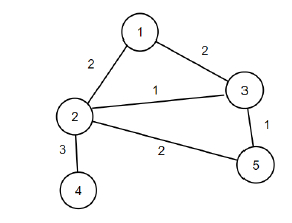n 個の頂点と m 個のエッジを持つ重み付き無向グラフがあるとします。グラフのスコアは、グラフ内のすべてのエッジの重みの合計として定義されます。エッジの重みは負の値になる場合があり、エッジの重みが削除されると、グラフのスコアが増加します。行う必要があるのは、グラフの接続性を維持しながらグラフ内のエッジを削除して、グラフのスコアを最小化することです。削減できる最大スコアを見つける必要があります。
グラフは配列 'edges' の形式で与えられ、各要素は {weight, {vertex1, vertex2}} の形式になります。
入力が n = 5、m = 6、エッジ = {{2, {1, 2}}、{2, {1, 3}}、{1, {2, 3} の場合}, {3, {2, 4}}, {2, {2, 5}}, {1, {3, 5}}} の場合、出力は 4 になります。

グラフからエッジ (1, 2) と (2, 5) を削除すると、スコアの合計減少量は 4 になり、グラフは接続されたままになります。
この問題を解決するには、次の手順に従います。
cnum := 0
Define an array par of size: 100.
Define an array dim of size: 100.
Define a function make(), this will take v,
par[v] := v
dim[v] := 1
Define a function find(), this will take v,
if par[v] is same as v, then:
return v
return par[v] = find(par[v])
Define a function unify(), this will take a, b,
a := find(a)
b := find(b)
if a is not equal to b, then:
(decrease cnum by 1)
if dim[a] > dim[b], then:
swap values of (a, b)
par[a] := b
dim[b] := dim[b] + dim[a]
cnum := n
sort the array edges based on edge weights
for initialize i := 1, when i <= n, update (increase i by 1), do:
make(i)
res := 0
for each edge in edges, do:
a := first vertex of edge
b := second vertex of edge
weight := weight of edge
if find(a) is same as find(b), then:
if weight >= 0, then:
res := res + 1 * weight
Ignore following part, skip to the next iteration
if cnum is same as 1, then:
if weight >= 0, then:
res := res + 1 * weight
Otherwise
unify(a, b)
return res理解を深めるために、次の実装を見てみましょう-
#include <bits/stdc++.h>
using namespace std;
int cnum = 0;
int par[100];
int dim[100];
void make(int v){
par[v] = v;
dim[v] = 1;
}
int find(int v){
if(par[v] == v)
return v;
return par[v] = find(par[v]);
}
void unify(int a, int b){
a = find(a); b = find(b);
if(a != b){
cnum--; if(dim[a] > dim[b]){
swap(a, b);
}
par[a] = b; dim[b] += dim[a];
}
}
int solve(int n, int m, vector <pair <int, pair<int,int>>> edges){
cnum = n;
sort(edges.begin(), edges.end());
for(int i = 1; i <= n; i++)
make(i);
int res = 0;
for(auto &edge : edges){
int a = edge.second.first;
int b = edge.second.second;
int weight = edge.first;
if(find(a) == find(b)) {
if(weight >= 0)
res += 1 * weight;
continue;
}
if(cnum == 1){
if(weight >= 0)
res += 1 * weight;
} else{
unify(a, b);
}
}
return res;
}
int main() {
int n = 5, m = 6;
vector <pair<int, pair<int,int>>> edges = {{2, {1, 2}}, {2, {1, 3}}, {1, {2, 3}}, {3, {2, 4}}, {2, {2, 5}}, {1, {3, 5}}};
cout<< solve(n, m, edges);
return 0;
}5, 6, {{2, {1, 2}}, {2, {1, 3}}, {1, {2, 3}}, {3, {2, 4}}, {2, {2, 5}}, {1, {3, 5}}}
4
以上がグラフから削減できる最大スコア要素を見つけるための C++ プログラムの詳細内容です。詳細については、PHP 中国語 Web サイトの他の関連記事を参照してください。